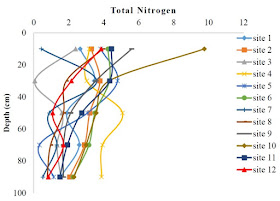by Niezel Jane D. Estrellanes
Volcanic soils such as
Andisols have many unique properties not usually found in soils derived from
other parent materials (http:/www.ctahr.hawaii.edu). They are often very young
and acidic depending on which type of volcanic materials they come from. They also
largely consist of non-crystalline minerals such as allophane and imogolite
(Nanzyo et al., 2002) which form strong bonds with organic matter thereby protecting
it from decomposition. Andisols are usually light textured and are easy to
till. However, they form strong complexes with phosphorus, rendering this
element unavailable to plants.
 |
| One of the sampling sites in the central volcanic highlands of Ormoc, Philippines |
This thesis research, a
component of the Australian Center for International Agricultural Research (ACIAR)
Soil Project based at the Visayas State University, evaluated the impact of
intensive vegetable production on the nitrogen and phosphorus levels of
volcanic soils in the central highlands of Leyte specifically in Cabintan,
Ormoc City, Philippines. Twelve sampling sites (vegetable farms) including a
reference site were chosen for this study. The objective was to find out if the
continuous and heavy application of fertilizers for intensive vegetable production
have caused the accumulation of nitrogen and phosphorous in Andisols.
 |
| Location of the sampling sites in Cabintan, Ormoc City |
Soil samples were taken
from the following soil depths 0-20, 20-40, 40-60, 60-80, and 80-100 cm using a soil
auger. They were air-dried and passed through 2-mm sieve and analyzed for
selected physical and chemical parameters such as pH (H2O, KCl, and NaF), available
phosphorus, and particle size distribution. Enough 2-mm samples were also ground
further and allowed to pass through 0.425-mm for organic matter content and
total N analysis.
Results revealed that the majority
of the vegetable farms sampled showed higher amounts of organic matter (OM),
nitrogen (N), and available phosphorus (P) than the reference site (secondary growth
forest). This clearly indicates the impact of the high and continuous
application of chemical and organic fertilizers (chicken manure). The very high
nitrogen contents of the soils point out to nitrogen pollution which could have a serious negative impact on the groundwater quality. The high available phosphorus
contents of the soils suggest improvement of the supply of this nutrient to the
crops considering the fact that it is the major limiting nutrient to crop
production in Andisols.
 |
| Soil OM contents of the sampling sites. Sites 2, 4, 6 and 7 have much higher values than the reference site 12. |
 |
| Soil N contents of the sampling sites. Most of the sites have much higher N levels than the reference site 12 |
 |
| Soil available P contents of the sampling sites. Reference site (12) has much lower P levels compared to all other sites. |
Based on the results it
can be concluded that:
a. The intensive vegetable
production has increased the nutrient status of the Andisol;
b. The frequent and
high rates of fertilizer application for the intensive vegetable production have greatly increased the nitrogen and phosphorus contents of the Andisol soil.
c. Nitrate and phosphate pollution of the groundwater and the nearby rivers may result from intensive vegetable production.
c. Nitrate and phosphate pollution of the groundwater and the nearby rivers may result from intensive vegetable production.
Thank you maam for sharing your important results.
ReplyDeleteDanny
Hi Danny,
ReplyDeleteThank you for writing a comment. If you have any question for Niezel Estrellanes, please just email me so I can forward it to her.